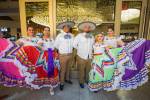Cinco de Mayo: History you can drink to
Uno ... dos ... tres. .. cuatro ... CINCO de Mayo!
While you’re timing how fast it takes you to drink that Corona, sucking down the lime as though it were a worm from a bottle of mescal , stop for just a second and try to figure out what Cinco de Mayo actually is. Contemplate its history.
OK, this is what Cinco de Mayo is NOT: It’s NOT Mexican Independence Day. That comes on Sept. 16.
It’s not Mexico’s version of St. Patrick’s Day, although it comes awfully close in spirit.
If you haven’t figured it out, don’t feel bad. You’re not alone.
Cinco de Mayo is a big-time holiday that honors a big battle between a woefully underarmed group of Indian peasants against a far superior French force during the days of the Civil War and Abraham Lincoln.
The battle occurred in Mexico, in a town called Puebla, on yes, May 5. It was 1862.
Kind of anti-climactic, right? What with all the pomp and circumstance and the blitz in advertising that surround the holiday, year in and year out.
“It’s really about celebrating who we are,” says Marisela Rebollar, a Tecate beer girl for whom business has been going bonkers this past week, handing out dollar-off coupons for cases of the Mexican beer at supermarkets that cater to the Latino population in Las Vegas.
For the Mexican-American who was born in the United States, there’s been this indescribable buzz about Cinco de Mayo ever since she can remember.
Erika Borges concurs. She’s in charge of finding unique cultural programs for the Winchester Cultural Center in Las Vegas. On Saturday night the auditorium was to be alive with folkloric dancing, long considered one of the artistic staples of the Latino culture.
However , beer-drinking and consumerism overshadow the historical significance of the holiday.
“I don’t like to admit it or even repeat it, but let’s face it, it’s become ‘Drunken de Mayo,’ ” said Borges, 32, who was born in Los Angeles and danced folklorico ballet as a child. “But if you look at the history of the battle, it’s really about being underdogs. It’s about a group of indigenous people who won a battle with minimal battle gear, and that’s something to be proud of.”
But as in all holidays, the history gets lost over time and is upstaged by the celebration itself , whether it’s overeating on Thanksgiving and forgetting that it was, in effect, a peace treaty between the Pilgrims and the Native Americans, or maxing out the credit card on Christmas, its religious meaning lost amid the shopping.
And let’s look at the history of Cinco de Mayo. The reason the French were invading Mexico was to claim a debt. Mexico had been suffering economically at the time, having undergone three back-to-back wars, starting with the Mexican-American War of 1846. Benito Juarez, the president in 1861, told Spain, Britain and France that he could not pay them back for the money they lent Mexico.
While Spain and Britain forgave Mexico its debts, France, led by Napoleon III, invaded the country, landing in Vera Cruz, then marching toward Mexico City, the ruling center of the country. But that’s when the Mexican army of peasants, outnumbered 2-to-1, fought them, pushing back their conquest for at least two years.
Although the French came back with thousands more troops and ultimately ruled the country between 1864 and 1867, some historians point out that if it hadn’t been for the battle of Puebla, the Civil War in the United States might have turned out differently because the French might have turned their sights on helping the Confederate side.
Another interesting aside is how the Chicanos in the United States during the civil rights movement of the ’60s resurrected and retold the battle at Puebla to advance their own cause. The story of that underdog army resonated with them. They related to it. They felt like underdogs.
Born in the United States but of Mexican parents, they felt lost and discriminated against. Many felt that American society at large didn’t accept them for who they were — the schoolteachers would punish them, even slap them with a ruler for speaking Spanish — and their only real tie to Mexico was the fact that their parents came from there.
It’s the same sort of cultural drama that’s playing out today with the DREAMers, a snapshot of how little has changed in the past four decades among the Mexican-Americans, many of whom may claim themselves as Hispanic on the census but at the core are indigenous, or mestizo, which means “mixed race.”
The epitome of what it means to be truly bilingual in both English and Spanish, Borges would argue that the Spanish language was forced upon the indigenous people by the Spanish conquistadores, led by Hernan Cortez in 1519.
And that’s what Cinco de Mayo is really about: recognizing one’s mixed heritage, which grew out of historical circumstances such as the Spanish conquest of the Aztec empire and highlighted by tales of heroism, as in the case of the battle of Puebla.
It’s some heavy stuff, which perhaps is best commemorated with a drink or two.
Contact reporter Tom Ragan at tragan@reviewjournal.com or 702-224-5512.




























